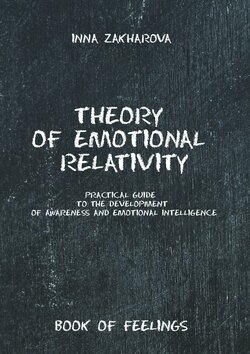Theory of emotional relativity. Practical guide to the development of awareness and emotional intelligence

Реклама. ООО «ЛитРес», ИНН: 7719571260.
Оглавление
Inna Zakharova. Theory of emotional relativity. Practical guide to the development of awareness and emotional intelligence
Preface
Gratitude
Human Needs
Self-perception
Self-confidence (security)
Self-love
Self-respect
Values
Nominalization
How do Values Form and Where do they Come from?
A Great Delusion
Value-forming
Security. Strategies and Values
Love. Strategies and Values
Respect. Strategies and Values
Values and Anti-values
Three Types of Joy
How to Define your Values?
Emotions
4 Types of Expressing Emotions
Fear
Fear. How does it Serve?
Fear. How does it Show up in the Body?
Fear. Processing
Fear. Ways to Cope
Fear. The Need and Strategies for Satisfying
Fear. A Healthy Way of Processing
Fear. Release
Fear. How to Help others?
Fear. Security and Responsibility
Shame
Shame. How does it Serve?
Shame. How does it Show up in the body?
Shame. Processing
Shame. A healthy Way of Processing
Shame. Release
Shame. Ways to Cope
Shame. The Need and Strategies. for Satisfying
Shame. How to Help others?
Disgust
Disgust. How does it Serve?
Disgust. How does it. Show up in the Body?
Disgust. Processing
Disgust. Ways to Cope
Disgust. Needs
Disgust. A Healthy Way of Processing
Disgust. Release
Anger
Anger. How does it Serve?
Anger. How does it Show up in the Body?
Anger. Processing
Anger. A Healthy Way of Processing
Anger. Release
Anger. Ways to Cope
Anger. The Need and Strategies. for Satisfying
Anger. Adult Position
Anger. How to Help others
Sadness
Sadness. How does it Serve?
Sadness. How does it Show up. in the Body?
Sadness. Needs and Values
Sadness. Processing
Sadness. Healthy Strategies of Processing
Sadness. Release
Sadness. Ways to Cope
Sadness. How to Help others
Surprise
Surprise. How does it Serve?
Surprise. How does it Show up. in the body?
Surprise. Ways to Cope
Surprise. Processing
Tenderness
Tenderness. How does it Serve?
Tenderness. Processing
Tenderness. How does it Show up. in the Body?
Tenderness. Transformational Strategies
Tenderness. Ways to Cope
Tenderness. Love
Tenderness. How to Accept Yourself
Desire
Desire. How does it Serve?
Desire. How does it Show up in the Body?
Desire. A Connection with Purposes
Desire. Needs and Forms of Joy
Desire. Ways to Cope
Desire. The Law of Development
Desire. Healthy Ways of Processing
Joy
Joy. How does it Serve?
Joy. How does it Show up in the Body?
Joy. Needs and Ways to Cope
Joy. Processing
5 Stages of Acceptance
The Balance of Feelings
Sadness – Joy
Desire – Disgust
Anger – Fear
Shame – Pride
Indifference – Empathy
Fear – Courage
Greed – Generosity
Respect – Arrogance
And again about Tenderness
Conscience
The Implementation of the Balance Law. in Parent-Child Relationships
The Implementation of the Balance Law. in Adult, Equal Partnerships
Resentment and Guilt are Organs of Conscience
Resentment
Guilt
Responsibility
Theory of Relativity
Previous Experience
A Child, an Adult or a Parent?
How to Look for the “Good”?
The Absence of Emotions
Focus of Attention
Emotional Manipulations
How to Recognize Manipulation
Fear Manipulation
Anger Manipulation
Sadness Manipulation
Disgust Manipulation
Shame Manipulation
Tenderness Manipulation
Desire Manipulation
Joy Manipulation
Resentment is a Way of Manipulation
Provocations
Sudden Danger (Fright)
Sudden Disrespect
Sudden Devaluation
“Toilet Trap” Provocation
Exposure Provocation
Sudden Conflict
Provocation with the Help of Tenderness
Provocation with the Help of Desire
Joy Provocation
Anti-manipulation Protection
Feelings
What are Feelings?
Resentment-containing Feelings
Disgust-containing Feelings
Surprise-containing Feelings
Sadness-containing Feelings
Fear-containing Feelings
Tenderness- and Joy-containing Feelings
Tenderness- and Desire-containing Feelings
Joy- and Desire-containing. feelings
Feelings, reflecting an attitude towards. time, towards the future
Guilt-containing Feelings
A Successful Strategy to Process. the Feelings of Guilt or Resentment
Instructions for Working with Feelings
Emuno Tips
Fear
Disgust
Anger
Shame
Sadness
Joy
Desire
Tenderness
Dictionary of Feelings
Instead of a conclusion
How can you Read this Book to your Profit?
“Emotional Intelligence EQ Test”
Interpretation of test results
Отрывок из книги
The development of emotional intelligence is gaining increasing importance (is becoming more popular nowadays). But what it means, no one fully understands. There are many definitions of this concept, the main one is the ability to understand and manage your own emotions and those of the people around you. But is that enough? What does it mean to understand emotions?
To understand the emotion, first of all, you should know how to identify it, give it a name and change if necessary. The mechanism of the birth of emotions is not so simple, the emotion is not born in a random order, it connects with our innermost psychological processes in the structure of our personality. Emotions are not only a reaction to the real circumstances in our life, but a kind of connection with our ancestors, with the more global systems – family, dynasty and nation. We feel only 10% of emotions from the present moment, the rest 90% is emotions in the combination of systemic feelings connected with our deepest convictions which appeared far in the past, long before our birth, they are kept in our subconscious and manage our life.
.....
There are three main strategies to satisfy the needs for security. As the strategies differ, values also may be different.
Strategies of getting values:
.....